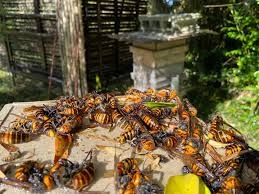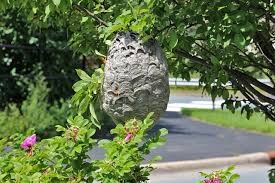The Hornets Who Built a Fortress in the Garden

The old, rambling estate known as The Garden was a territory of abundant resources, manicured beauty, and a complex, often fragile, order.
While the Bees busied themselves with productive, democratic pollination and the Butterflies fluttered through the sunny sectors, the true power had recently been seized by a relentless, dark collective: the Hornets.
These were the Hornets Who Built a Fortress in the Garden. They symbolized extremist political movements, militant religious factions, or highly organized, aggressive fundamentalist groups.
Their power was derived from their absolute ideological purity, their decentralized fanaticism, and their willingness to use swift, overwhelming force to achieve their rigid vision of order.
They didn't seek consensus or trade; they sought total dominion and the forced conformity of the entire ecosystem.
Their fortress, a massive, imposing structure built from chewed wood and fear, was meticulously constructed high in the central oak tree—the symbolic seat of governance. It was led by the unseen, legendary figure known only as The Queen of Iron, whose decrees were enforced by the terrifying, heavily armed legions of Stingers.

The Doctrine of the Nest
The Hornets’ ideology was simple and terrifying: Order through Submission. They viewed the Bees' democratic processes as weak and chaotic, the Butterflies' aesthetics as frivolous, and the Ants' (laborers) tireless work as simply a resource to be commandeered.
Their actions were governed by a strict, non-negotiable set of rules laid down by the Queen of Iron. These rules dictated everything from what kind of flower was permissible (only the dull, brown ones that yielded practical wood fiber for the nest) to the correct way to fly (straight lines, no frivolous loops). Any deviation was heresy, met with immediate and brutal punishment.
The Hornets’ presence cast a long shadow over the Garden. The smaller, non-aligned insects lived in a state of perpetual fear. The Ladybugs, who carried valuable seeds and information, often had their cargoes confiscated for "inspection." The Grasshoppers, whose music was a symbol of freedom and joy, had been forced into silence.
The Hornets were careful in their dealings with the true giants of the wider territory. They avoided the direct wrath of the Lions, but they expertly used the fear they instilled to extract protection money from the Rabbits and Squirrels who lived near the borders, claiming to defend them against external threats while, in reality, they were the greatest threat themselves.

The Conflict with the Bees
The core of the Hornets' hostility was directed at the Bees. The Bees, with their open hive structure, their democratic decision-making (the "Waggle Dance"), and their focus on collective productivity, were the antithesis of the Hornets' rigid, totalitarian system.
The Hornets didn't want to simply plunder the Bees' honey; they wanted to destroy the idea of the hive.
A major conflict flared over the Water Lily Pond, a large, beautiful source of fresh water crucial for both communities. The Bees had an established, efficient system for sharing the water rights. The Queen of Iron decreed that the Pond was "Sacred Water" and that the Bees' system of sharing was "profane and inefficient."
The Hornets seized the Pond, not to use all the water, but to enforce a new, complex set of rules for its use. They forced all insects to queue in a single, rigid line, inspected every visitor's antennae for "ideological purity," and often demanded a tribute of nectar before granting access. The process was slow, humiliating, and designed to assert the Hornets' absolute control over a universal resource.
When the Bees tried to send a diplomatic delegation—three of their most respected, veteran foragers—to negotiate, the Hornets met them with devastating hostility. They didn't kill the Bees; they viciously tore the wings off the lead Bee, crippling her and leaving the others alive to carry the terrifying message back to the hive: Dialogue is an act of war against the established Order.

The Failure of External Intervention
The brutality of the act finally stirred the larger powers. The Elephants (international bodies) sent a cautious delegation to the edge of the Garden, issuing a sternly worded "Statement of Collective Concern" about the disruption of the water supply and the violence against the Bees.
The Hornets reacted with a calculated act of defiance. They didn't attack the Elephants. Instead, they dispatched a small, highly trained team to attack the Crows' (media surveillance) main relay station on a nearby shed roof. They didn't destroy the equipment; they simply coated the Crows' lenses with a highly sticky, darkening resin.
The effect was instantaneous. The Crows' live feed went dark, the horrifying images of the crippled Bee and the choked Pond replaced by static. The Hyenas immediately began cackling that the "Bee-Elephant Conspiracy" was falling apart and that the violence was "staged." The Hornets had successfully shut down the outside world's access to objective truth, leaving the Elephants' policy statement to flounder in a sea of speculation and competing narratives.
Meanwhile, within the Fortress, the Queen of Iron was consolidating her control. She decreed that the remaining Bees must immediately begin "contributing" their honey to the Fortress's internal reserve, a move that would starve the Bees' own hive and dismantle their social structure from within.
The Bees, horrified by the violence and isolated by the political chaos, were unable to fight back against the Hornets' overwhelming, coordinated fanaticism. They had the moral high ground, but the Hornets had the military might and the unified will. The Bees were forced to begin their grim tribute, their complex, democratic society slowly unraveling under the pressure of the Hornets' rigid, totalitarian demands.
The Fortress in the Garden was complete. It was a monument not to strength, but to the devastating efficiency of fanaticism and centralized, unyielding ideological control, proving that in a fragmented world, the most dangerous enemy is the one who is willing to destroy the system to enforce their vision of order.
- Questions and Answers
- Opinion
- Motivational and Inspiring Story
- Technology
- Live and Let live
- Focus
- Geopolitics
- Military-Arms/Equipment
- Безопасность
- Economy
- Beasts of Nations
- Machine Tools-The “Mother Industry”
- Art
- Causes
- Crafts
- Dance
- Drinks
- Film/Movie
- Fitness
- Food
- Игры
- Gardening
- Health
- Главная
- Literature
- Music
- Networking
- Другое
- Party
- Religion
- Shopping
- Sports
- Theater
- Health and Wellness
- News
- Culture

